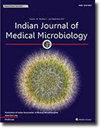Molecular and genomic characterization of Leptospira isolates in humans and its relation to disease severity
IF 1.4
4区 医学
Q4 IMMUNOLOGY
引用次数: 0
Abstract
Objective
The study was conducted with the aim to find out the genomo species and serovars of Leptospira by gene sequencing among blood samples tested positive for Leptospira PCR and to identify the species associated with highest mortality.
Methods
All samples with Ct value less than 35 were included in the study. After lipL32 PCR amplification and agarose gel electrophoresis, the amplified products were subjected to gene sequencing. Demographic details and mortality data were obtained from records.
Results
66 out of the 70 samples showed maximum similarity to L.interrogans in sequencing. Other species identified include L.kirschneri and L. noguchi (5 samples). Among those tested positive, 14 patients died. L.interrogans was frequently isolated (13/14)from those who died.
The different serovars identified include serovar canicola/hardjo/copenhageni, manilae/bataviaea/lai/icterohaemorrhagiae. Of these, serovars identified in death include Serovar canicola/hardjo/copenhageni/ranaram/manila.
Conclusion
Following sequencing, we identified the predominant species as L. interrogans (91 %) with case fatality rate of 19 %. They are found in animal population of our area, pointing the zoonotic potential of Leptospira. This highlights the need for sensitization of those with animal exposure regarding preventive strategies.
人类钩端螺旋体分离株的分子和基因组特征及其与疾病严重程度的关系。
目的:通过钩端螺旋体PCR检测阳性血液样本的基因测序,了解钩端螺旋体的基因组种类和血清型。我们还想知道死亡率最高的物种。方法:所有Ct值小于35的样本均纳入研究。琼脂糖凝胶电泳扩增后,对扩增产物进行基因测序。从记录中获得人口统计细节和死亡率数据。结果:70份样品中有66份在序列上与l .审问菌最相似。其他鉴定种包括L.kirschneri和L. noguchi(5个样本)。在检测呈阳性的患者中,有14人死亡。从死亡患者中分离出l .询问者较多(13/14)。已确定的不同血清型包括canicola/hardjo/copenhageni血清型、manilae/bataviaea /lai/黄疸出血热血清型。在死亡病例中发现的这些血清型包括canicola血清型/hardjo血清型/哥本哈根血清型/拉纳拉姆血清型/马尼拉血清型。结论:经测序鉴定,优势种为疑问乳杆菌(91%),病死率为19%。在我区动物种群中均有发现,提示钩端螺旋体有人畜共患的可能。这突出表明需要使所有接触动物的人对预防策略敏感。
本文章由计算机程序翻译,如有差异,请以英文原文为准。
求助全文
约1分钟内获得全文
求助全文
来源期刊

Indian Journal of Medical Microbiology
IMMUNOLOGY-
CiteScore
2.20
自引率
0.00%
发文量
154
审稿时长
73 days
期刊介绍:
Manuscripts of high standard in the form of original research, multicentric studies, meta analysis, are accepted. Current reports can be submitted as brief communications. Case reports must include review of current literature, clinical details, outcome and follow up. Letters to the editor must be a comment on or pertain to a manuscript already published in the IJMM or in relation to preliminary communication of a larger study.
Review articles, Special Articles or Guest Editorials are accepted on invitation.
 求助内容:
求助内容: 应助结果提醒方式:
应助结果提醒方式:


